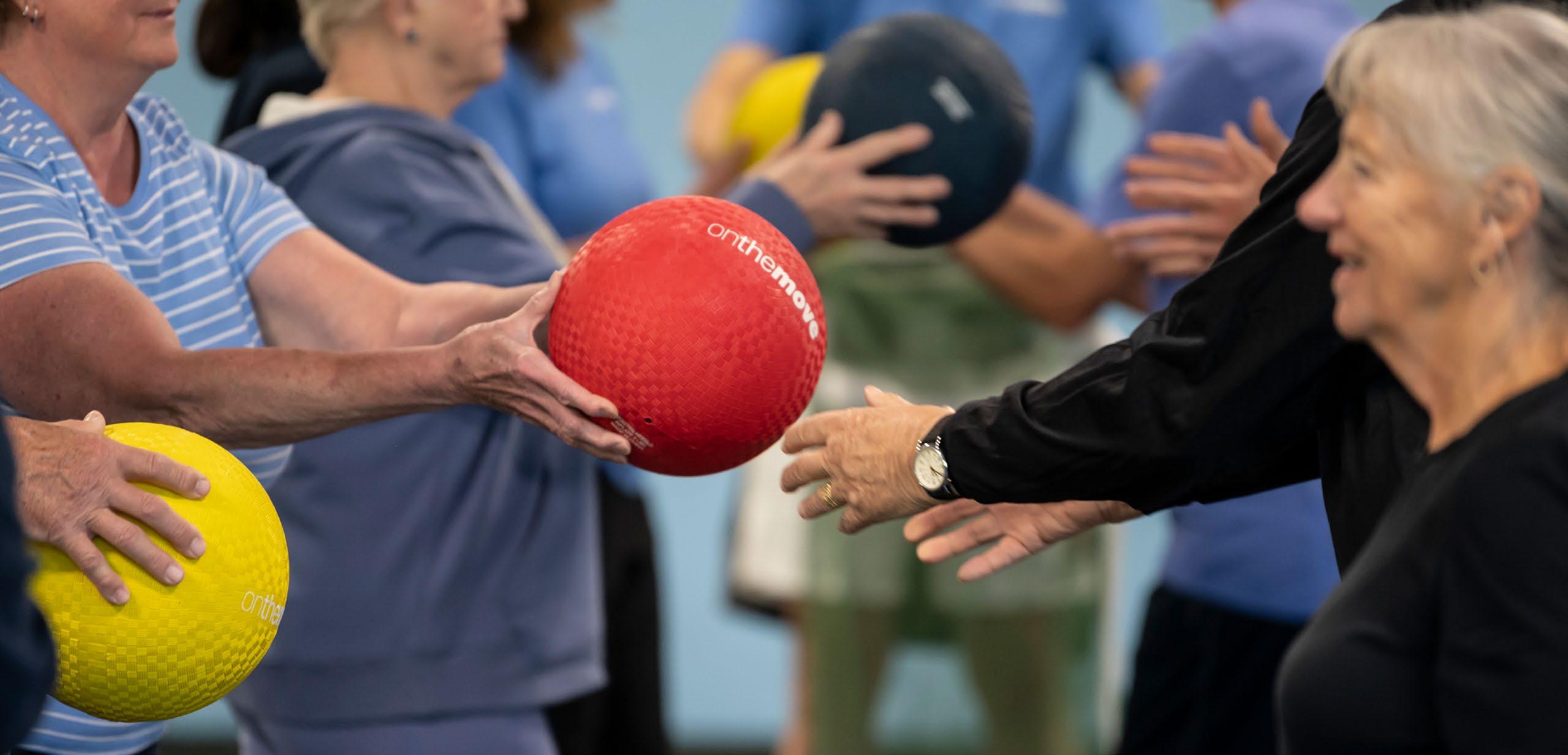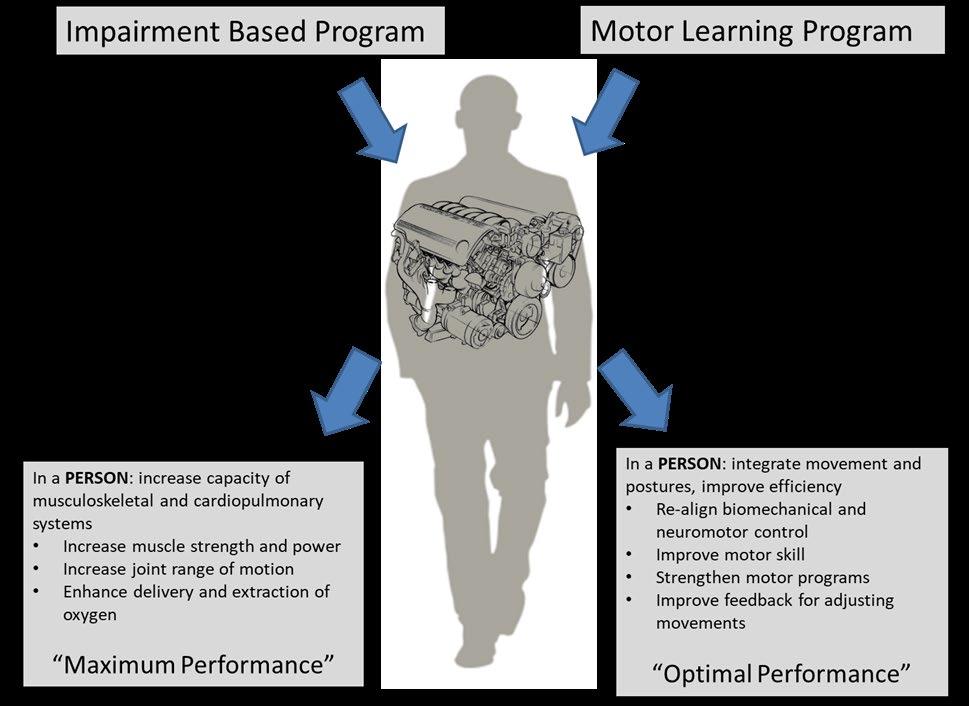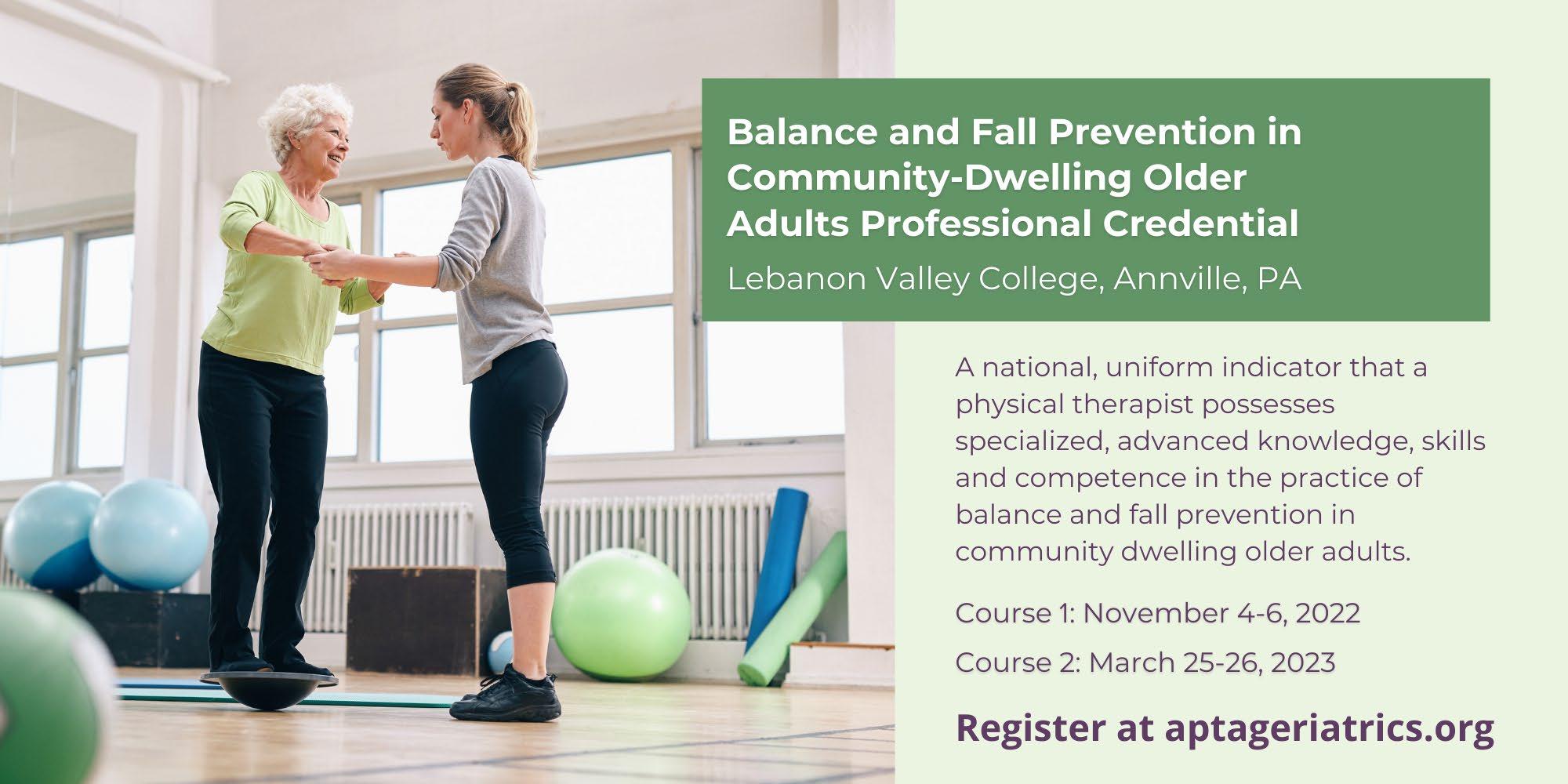
13 minute read
On the Move: Bridging the Gap between Clinical Practice and Community
by Jennifer S. Brach, PT, PhD, FAPTA; Valerie Shuman, PT, DPT; Gardenia A. Juarez, MA; Corey S. Flynn, MPPM; and Kaitlin Sweeney, BS
The ageing baby-boomer generation requires alternative models to extend care for wellness, health promotion, and maintenance of independence. High quality community programs address 2 key concerns in the ageing process: primary prevention, (through chronic disease self-management, physical activity, behavioral health, and fall prevention programming); and tertiary prevention, as a continuation of care for people when skilled physical therapy ends. The Agency for Healthcare Research and Quality (AHRQ) highlights the need for sustainable links between clinical and community settings to enhance prevention and improve care of those with chronic disease. Community-based organizations such as area agencies on ageing, senior centers, faith-based organizations, and YMCAs, offer various evidence-based programs (EBPs) to address this need of the ageing population. Yet there is a lack of EBPs extending clinical physical therapy care as patients transition from skilled therapy to the community. On the Move (OTM), a group-based exercise program founded on key physical therapy principles, fits this need.1
Advertisement
On the Move is a motor learning, group-based exercise program designed to improve the quality of walking. We translated a motor learning rehabilitation program originally delivered by a physical therapist 1:1 with patients into a group-based exercise program for communitydwelling older adults.1 The OTM program is based on stepping and walking patterns to promote appropriate timing and coordination of stepping throughout the gait cycle. In contrast to traditional impairment-based exercise programs, which focus on building capacity of the musculoskeletal and cardiopulmonary systems, OTM improves the efficiency of movement by integrating movements and postures during walking (Figure 1).2 The OTM program encourages high quality movement through accurate practice instead of high repetition of practice.
The OTM program is delivered twice a week for 12 weeks for a total of 24 classes. Each class is approximately 60 minutes long and encompasses a warm-up, stepping and walking patterns, strengthening exercises, and a cool-down (Table 1). The exercises are done to music selected to complement or facilitate the activity. Though a group class, the exercises can be modified or adjusted to meet the individual needs of the participants. For example, the backward stepping task can be modified by using upper extremity support or increasing or decreasing the pace of the stepping. OTM is a progressive program. The instructor will modify the activity/task to make it more challenging as participants master the activity. The goal is for participants to achieve high loads of accurate practice (i.e., quality over quantity). Once an activity is completed accurately at least 80% of the time, it is progressed and made more challenging. If the participants struggle with an activity and are not completing it accurately, the activity is modified to make it less challenging, even within the group setting. Completing heavy repetition of the most basic walking patterns with
accurate movements by any individual is more valuable than progression to a more intense pattern if they cannot maintain their "form."
On the Move differs from other evidence-based exercise programs in several important ways. First, it was developed by physical therapists. Principles of motor control were used to enhance the “skill” of walking or smooth automatic movement control. These walking and stepping patterns are unique in that they are based on the biomechanics of good walking. Each exercise was designed with a specific purpose in mind (Table 1). Whereas many exercise programs include strengthening and aerobic exercises to target the musculoskeletal and cardiovascular systems, the OTM program includes walking and stepping patterns that are timing and coordination exercises to target the nervous system. The goal of OTM is to improve the timing and coordination or quality of movement (i.e., improve efficiency) instead of building endurance and strength (i.e., build capacity). Second, OTM was based on physical therapy clinical practice. The developers took exercises that were delivered 1:1 by a physical therapist to improve walking and converted them into exercises that could be delivered in a group setting. We recognize the value of allowing participants to progress at an individual pace, therefore our exercises can be adapted for each person despite the group all performing related tasks (e.g., walking patterns). Importantly, this allows participants to feel the benefits of group exercise while adhering to the principles of progressing at an individual pace.
On the Move History
It has taken many years and significant research to develop On the Move. The exercises were first developed to be delivered 1:1 between a physical therapist and a patient. Several research studies we conducted demonstrated the effectiveness of this individualized approach.3-6 With the goal of reaching a greater number of individuals in the community, our stakeholders (manage-
Figure 1. Building a bigger engine versus a better engine: A comparison between impairment-based and task-specific motor learning exercise programs. Reprinted with permission from Brach JS, Vanswearingen JM. Interventions to Improve Walking in Older Adults. Curr Transl Geriatr Exp Gerontol Rep. 2013 Dec;2(4):10.1007/s13670-013-0059-0. doi: 10.1007/s13670-013-0059-0. PMID: 24319641; PMCID: PMC3851025.

ment of senior living) encouraged us to translate this rehabilitation program into a group exercise program.7 The translation process involved multiple phases, including meetings with experts in the field, focus groups with older adults, and pilot testing the newly developed program.1 Based on the feedback from experts in the field and the older adults we made adjustments to various aspects of the program including format/length, music, education, and group interaction. For example, participants reported enjoying interacting with each other during the exercises, therefore we incorporated interaction through partner and group stepping activities. Pilot testing of the program in thirty-one older adults demonstrated the program was safe and acceptable and resulted in potentially clinically meaningful improvements in mobility. The next step in the process involved a large cluster-randomized trial in which we compared OTM to a standard sit-and-be-fit group exercise program.7 OTM was superior to the standard program in that older adults who participated in OTM could walk farther (as measured by the 6-minute walk test) and faster (as measured by 4-m gait speed) than older adults who participated in the standard program. In addition to the mobility outcomes, the participants were highly satisfied with the program.8
OTM Recognized as an Evidence-Based Program
In February 2018, OTM was designated as an evidence-based program by the Administration for Community Living (ACL). This official designation differs from the general concept of evidence-based practice, broadly defined as interventions supported by research. The ACL determines if a program qualifies for evidence-based designation based on the quality of the scientific evidence, evidence that the program has been fully translated in one or more community sites, and the availability of developed dissemination products that are available to the public. The designation is important because senior community centers can receive government funding from the Older Americans Act (i.e., Title III D funding) to support evidence-based programming. Having obtained the evidence-based designation for OTM promotes the sustainability of the program, as centers can utilize government funding to pay for the delivery of the program. Part of the process for obtaining evidencebased status included developing a “packaged program” with a variety of supportive materials so the program can be consistently delivered with high fidelity and developing a system for training instructors.
Training of OTM Instructors
The On the Move program is delivered by certified OTM instructors. Individuals who can be trained as OTM instructors include health professionals (PTs, PTAs, OTs, etc.) and group fitness instructors. We find individuals who have an interest in fitness and a love of older adults make the best instructors. Training of OTM instructors
Table 1. On the Move: Program Components purpose and rationale
Program Component
Warm-up
Walking patterns (curves) • Ovals • Spirals • Serpentine
Stepping patterns • Backwards • Forward and across • Combination patterns
Strengthening exercises
Cool-down
Purpose/Rationale
Prepare the cardiovascular, musculoskeletal, and most importantly the nervous system for the upcoming exercises. Promote the appropriate timing and coordination of stepping throughout the gait cycle by enhancing proper weight shift during stepping and interlimb timing during walking. • Facilitates appropriate muscle recruitment (hip adductors on the stepping leg and hip abductors on the trailing leg) • Induces extension of the stance limb behind the body • Encourages maintenance of enhanced forward momentum while moving Promote the appropriate timing and coordination of stepping during gait using accurate repetitions of real steps. • Loads trailing limb • Shifts the center of pressure posterolateral • Encourages hip extension and the neural signal for stepping • Generates momentum to stance leg • Activates hip abductors with opposite side adductors • Facilitates neural stepping signal through stance Increase lower extremity muscular strength specifically targeting lower extremity muscles important for walking (e.g., hip abductors, hip extensors, ankle plantar flexors, etc.) Allow the body systems, specifically the cardiovascular system, to slowly return to a resting state. Also includes stretching exercises that address flexibility in lower extremity muscles related to walking.
Become an

Certified Instructor!
On the Move (OTM) is an evidence-based group exercise program for older adults designed to target the timing and coordination of walking. The program challenges the brain to match the timing and sequences of movements with posture to improve the smoothness and efficiency of walking. As a certified instructor, you will be equipped to teach OTM group exercise classes. The principles of OTM can also be incorporated in to every day clinical practice.

Course Overview
This course is a mix of synchronous (live presentation) and asynchronous (at your own pace) material. The live components will occur in two half-day segments.
Virtual Live Day 1 (4 hours):
Wednesday November 2, 2022, 8 am - 12 pm EST
Virtual Live Day 2 (4 hours):
Thursday, November 3, 2022, 8 am - 12 pm EST Registrants must attend both half days for certification.
Register by October 1, 2022: $450 Register after October 1, 2022: $500.
REGISTER HERE: https://www.onthemove.pitt.edu/ instructors/become-an-instructor/
NOTE ON CONTINUING EDUCATION UNITS:
Continuing education requirements are regulated by the state boards of physical therapy. Each state licensing board has its own policies and procedures related to continuing education of its licensees. State boards of physical therapy place the responsibility on licensees to follow rules and regulations related to the practice of physical therapy and maintenance of licensure in their states. Licensees should verify acceptance of continuing education courses with their state licensing board by reviewing the relevant state practice act and/or administrative code. This course has been preapproved for 10 CEU’s for the State of Pennsylvania. Please reach out to us with any questions. You can email us at contact@onthemove.pitt.edu. was initially conducted as an in-person course. To expand the reach of the training, we transitioned to include virtual and hybrid training options. The training includes approximately 12-14 hours of material which includes lectures, laboratories, group activities, and case studies. Core principles of motor control and appropriate progressions based on accurate practice are emphasized; clinicians and fitness instructors alike can deliver the program appropriately. Trained instructors have access to recorded lectures, a written manual, a video exercise library, and the OTM support team. Training occurs 3-4 times a year with additional trainings conducted on request. The next virtual training is Nov. 2 and 3, 2022. Details at www.onthemove.pitt.edu.
Bridging the Clinic-Community Gap
Walking difficulty is related to negative outcomes such as falls, mobility disability, hospitalization, nursing home placement, and death.9-11 Recent studies have shown improvements in walking may mitigate these negative outcomes.12 Older adults are often not referred to treatment for mobility problems and seniors may seek solutions for mobility issues through community resources. Community-based programs to improve mobility can serve as an extension of skilled therapy (once therapy ends) or prevention of the development of walking difficulty. On the Move, which translated a novel motor learning exercise program into a group-based exercise program, allows it to be offered as a community-based program. Hence, providing evidence-based therapeutic exercise to older adults who would benefit, whether they would qualify for, have access to, or have been referred for physical therapy services. The On the Move program provides the opportunity to reach more individuals in a cost-effective manner. Many community-based organizations need instructors who can deliver these high-quality evidence-based programs, which provides the perfect opportunity for physical therapists interested in improving the health and wellness of older adults.
References
1. Brach J, Francois S, VanSwearingen J, Gilmore S, Perera S, Studenski S. Translation of a motor learning walking rehabilitation program into a group-based exercise program for community-dwelling older adults. PMR. 2016;8:520-528. 2. Brach J, VanSwearingen J. Interventions to improve walking in older adults. Curr Transl Geriatr and Exp Gerontol Rep. 2013;2:230-238. 3. Brach J, Lowry K, Perera S, et al. Improving motor control in walking: a randomized clinical trial in older adults with subclinical walking difficulty. Arch Phys Med Rehabil. 2014;96:388-394. 4. Brach J, VanSwearingen J, Perera S, Wert D, Studenski S. Motor learning versus standard walking exercise in older adults with subclinical gait dysfunction: A randomized clinical trial. J Am Geriatr
Soc. 2013;61:1879-1886. 5. VanSwearingen J, Perera S, Brach J, Cham R, Rosano C, Studenski
S. A randomized trial of two forms of therapeutic activity to improve walking: effect on the energy cost of walking. J Gerontol A Biol Sci
Med Sc. 2009;64A:1190-1198. 6. VanSwearingen JM, Perera S, Brach JS, Wert D, Studenski SA. Impact of exercise to improve gait efficiency on activity and participation in older adults with mobility limitations: a randomized controlled trial. PhysTher. 2011;91(12):1740-1751. 7. Brach J, Perera S, Gilmore S, et al. Stakeholder involvement in the
design of a patient-centered comparative effectiveness trial of the “On the Move” group exercise program in community-dwelling older adults. Contemp Clin Trials. 2016;50:135-142. 8. Brach J, Perera S, Gilmore S, et al. Effectiveness of a timing and coordination group exercise program to improve mobility in community-dwelling older adults: A randomized clinical trial. JAMA
Intern Med. 2017;177(10):1437-1444. 9. Studenski S, Perera S, Patel K, et al. Gait speed and survival in older adults. JAMA. 2011;305(1):50-58. 10. Cesari M, Kritchevsky SB, Penninx BWHJ, et al. Prognostic value of usual gait speed in well-functioning older people—results from the health, aging and body composition study. J AM Geriatr Soc. 2005;53(10):1675-1680. 11. Perera S, Patel K, Rosano C, et al. Gait speed predicts incident disability: a pooled analysis. J Gerontol Med Sci. 2016;71(1):63-71. 12. Shuman V, Coyle PC, Perera S, Van Swearingen JM, Albert SM,
Brach JS. Association Between Improved Mobility and Distal Health
Outcomes. J Gerontol A Biol Sci Med Sci. 2020;75(12):2412-2417.
Jennifer S. Brach, PT, PhD, FAPTA is a Professor in the Department of Physical Therapy and Associate Dean for Faculty Affairs and Development in the School of Health and Rehabilitation Sciences at the University of Pittsburgh. Dr. Brach has over 20 years of experience conducting research to improve the mobility of older adults. She is one of the creators of the On the Move program.
Valerie Shuman, PT, DPT, GCS, is an assistant professor in the Department of Physical Therapy at the University of Pittsburgh. Dr. Shuman has worked clinically and in research with older adults with mobility limitations and has been involved with On the Move for the past 5 years. Gardenia A. Juarez, MA is a Kinesiologist and a second-year doctoral student researcher in the Department of Physical Therapy at the University of Pittsburgh. Ms. Juarez has worked in community-based programming for older adults and has been involved with On the Move for the past two years.
Corey S. Flynn, MPPM is a Research Coordinator in the Department of Physical Therapy at the University of Pittsburgh.
Kaitlin Sweeney, BS is research staff in the Department of Physical Therapy at the University of Pittsburgh.








